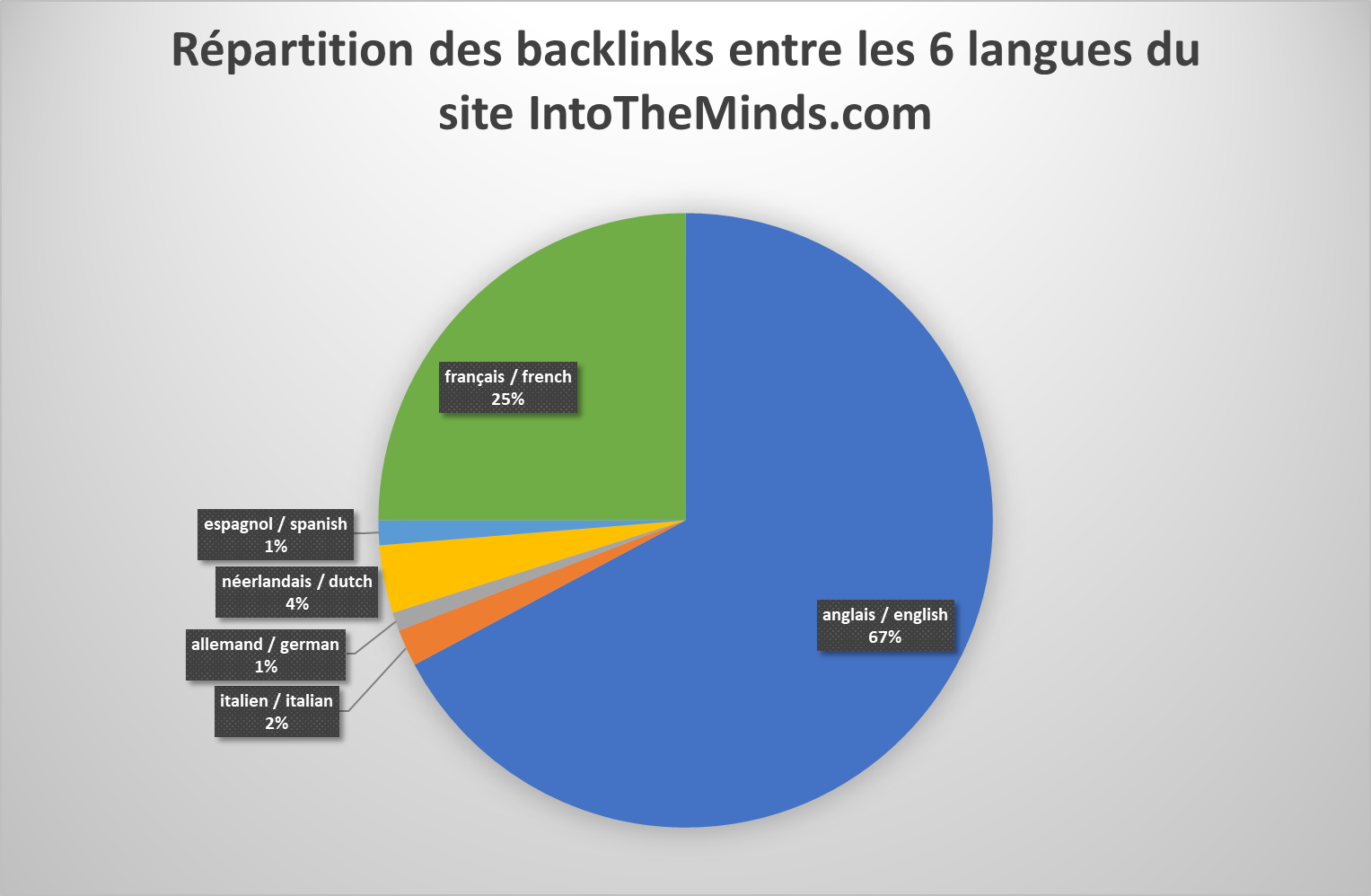The question is legitimate: Should you translate your website or blog to increase the number of backlinks? To answer this question, I individually analyzed all the good backlinks (do-follow, DR>20) on my website. In addition to the type of content that generated these backlinks, I also looked at the language of the referring website and the language of the page to which the backlink pointed. As this blog is translated into 6 languages, I needed to understand whether my investment was wise.
Contact IntoTheMinds marketing agency
Translations and backlinks: the statistics
- 75% of backlinks point to a translation in one of the following 5 languages: English, Italian, Spanish, German, Dutch
- French pages account for 25% of my backlinks
- 7% of websites backlink to a page in the same language
- 2% of English-language websites backlink to other English-language websites
- 4%of French websites backlink to other French websites
- Only 89% of backlinks come from a page with a Domain Ranking >20
Translating content is a costly and complex process. I experience this daily with my blog, which I decided to translate into several languages very early on. I started with one language (French), then added English and Dutch (because my company is active in BeNeLux). In 2021, I added Spanish, then German and Italian in 2022. These translations cost around €20,000 each year. To find out whether the investment is worthwhile, I propose you follow me in analyzing my backlinks.
How do you analyze the language of your backlinks?
How do you analyze the language of your backlinks?
To conduct this analysis, I used Ahrefs. I extracted the list of all do-follow backlinks originating from a domain with a Domain Ranking (DR) greater than 20 over the last 6 months (this is the maximum history with my Ahrefs subscription). I’ve only included links in content to avoid considering link farms that place links on images.
Finally, I exported this list of 340 backlinks and analyzed each link to determine the languages of the page linking and the language of the page on my website to which the link pointed.
75% of backlinks point to a translation
32 backlinks pointed directly to my flagship website (with no language indication). Therefore, I set them aside in the analysis, and the following figures are calculated on 308 do-follow, in-content backlinks with a Domain Ranking of 20 or more.
Although my blog is originally French-speaking, English dominates the backlinks. 67% of my backlinks with a DR>20 points to the English translation of my website. French comes second (25%), followed by Dutch (3.6%), Italian (1.9%), Spanish (1.3%) and German (1%).
I was quite surprised by the score for the Dutch. I was surprised to generate many interesting backlinks for a relatively rare language. On the other hand, the shares for Spanish, Italian, and German remain disappointing, even if it’s true that I added these translations recently (2021-2022). I’ve only translated a small part of the blog into these languages, and that’s where the problem lies. As is often the case in SEO, results come in the long term.
If you want to attack SEO in a particular country, you MUST write in the language of that country.
72.7% of pages backlink to a page in the same language
It’s also interesting to analyze whether qualitative websites prefer to add a backlink to a page in the same language as their own. The answer is yes: 72.7% of websites prefer the same language, and this applies to all languages:
- French: 91.4%
- English: 97.2%
- Italian, Dutch, German, Spanish: 74.2%.
The conclusion is crystal clear. If you want to attack SEO in a particular country, you MUST write in the language of that country. This conclusion seems obvious, yet I’ve seen many customers whose content (website, blog) needed to be translated into the language of the country where they were present. It’s a mistake often made by companies exporting to a new country. And yet, as I showed in this research, there are plenty of SEO opportunities in languages other than English.
If your translation budget is limited, translate only into English.
Will I continue to invest in translations?
For English, the question doesn’t even arise. Nearly 2/3 of my backlinks are in this language. So, it’s an excellent investment. If your translation budget is limited, translate only into English.
For other languages, the results are more mixed. Italian, Dutch, German, and Spanish account for barely 8% of my qualitative backlinks. In the case of Dutch, this is due to the limited number of websites in Dutch. You must wait for more translated articles for the other languages to rank well in the language in question (and be found in the search engines).
So, I will continue investing in qualitative translations but limit myself to the current 6 languages. I don’t see any need to add new languages, as this would fall outside the geographical scope of our market research activities.
Posted in Research.

